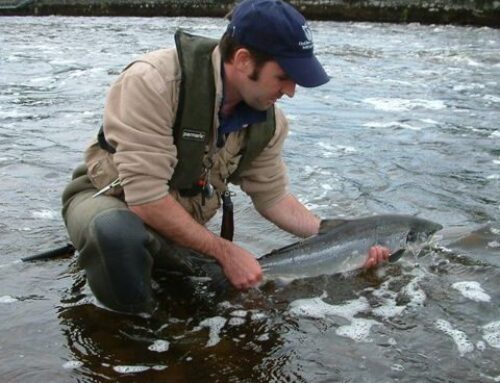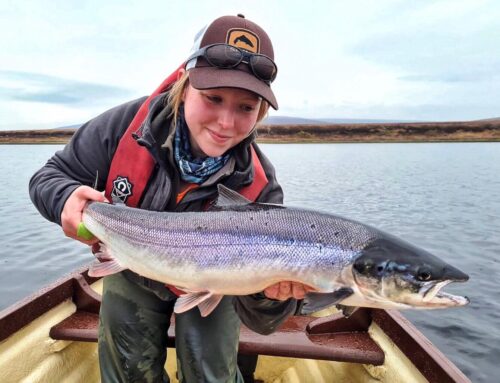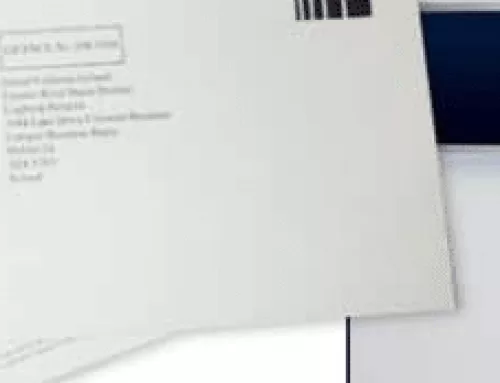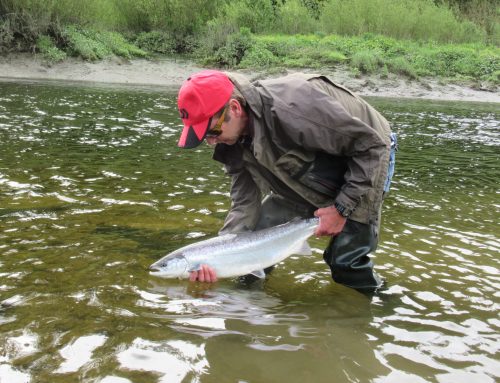The Wild Salmon and Sea Trout Tagging Scheme regulates salmon and sea trout fishing in Ireland and is administered by Inland Fisheries Ireland. Please note that the regulations and bye-laws are subject to change. Contact your local Inland Fisheries Ireland office for information on individual rivers.
All salmon rod licence holders must affix a gill tag to all retained salmon (any size), or sea trout (over 40 cm).
Sustainable angling and biosecurity
- Always Fish Sustainably
- Check Clean Dry Check
- We all need to fish sustainably, so that our fisheries can be enjoyed by future generations. Please practice Catch & Release for the majority of the fish you catch. When moving between fisheries, always make sure to Check, Clean and Dry your equipment, to help stop the spread of invasive species. For more information see: https://www.fisheriesireland.ie/what-we-do/research/research-theme-biosecurity
- If you need to report illegal fishing or water pollution Call 0818 34 74 24
1. BAG LIMITS
There is an angling bag limit of 10 salmon (any size) or sea trout (over 40 cm) on rivers where you may catch and retain salmon (Table 1). The bag limits are subject to any quota allocated to a river and its tributaries.
Subject to the maximum annual bag limit of ten fish an angler may take:
- Daily Bag Limit – January 1st to May 11th: A total of one salmon (any size) or sea trout (over 40cm) per day (three fish in total may be retained for this period).
- Daily Bag Limit – May 12th to August 31st: Three salmon (any size) or sea trout (over 40cm) per day (except where a salmon rod (one-day) ordinary licence is held, 1 fish).
- Daily Bag Limit – 1st September to the close of the season: One salmon (any size) or sea trout (over 40cm) per day.
- There is an angling bag limit of three sea trout (under 40cm) per angler per day.
- Please note that it is an offence to kill any sea trout in the following waters;
-Galway, Connemara or Ballinakill Fisheries Districts including at sea from Hags Head in County Clare to Clew Bay (and in any waters flowing into Clew Bay) in the Bangor Fishery District south of a line drawn due east and west through Achill Head.
– Kerry District, in that part of the sea east of a line between Bolus Head and Lambs Head and all the waters discharging into it (i.e. Waterville area)
After the daily bag limit has been taken, anglers are permitted to fish catch and release, using single or double, barbless hooks and anglers may not use worms. The killing and possession of foul hooked fish is prohibited.
On rivers where catch and release is permitted (Table 2):
- anglers may not use worms,
- anglers must use single or double, barbless hooks,
- the fish must be handled carefully and should not be removed from the water prior to release.
On all other rivers (Table 3) angling for salmon (any size) and sea trout (over 40cm) is prohibited.
- The Regulations on the River Avoca prohibit the taking of any sea trout (under 40cm) as well as prohibiting the use of worms as bait and any fish hooks other than single barbless hooks in angling for sea trout (under 40cm) (Bye-law no. 890, 2011)
- The Regulations on the River Slaney prohibit the use of; (a) any lure other than artificial fly using single or double barbless hooks in that part of the River Slaney upstream from the Railway Bridge Enniscorthy, or (b) worms as bait or any fish hooks, other than single barbless hooks, in that part of the River Slaney downstream from the Railway Bridge Enniscorthy to the mouth of the River Slaney. Conservation of Salmon and Sea Trout (River Slaney) Bye-law No. 992 of 2021
- The Regulations on the River Suir prohibit the use of worms, prawn, shrimp or any other crustacean or artificial forms thereof as bait and any fish hooks other than single or double barbless hooks. Conservation of Salmon and Sea Trout (River Suir) Bye-law No. 991 of 2021
2. OBTAINING A LICENCE
Anglers can obtain their licence from Inland Fisheries Ireland or any rod licence distributor. On payment of the rod licence fee, the angler will be given:
- The relevant rod licence, associated logbook and a plastic wallet for the licence/logbook.
- 3 gill tags where a salmon rod (annual) ordinary, juvenile, district or 21-day ordinary licence is issued up until 11th May and a further 7 gill tags (issued in lots of 3 or 4) from the period 12th May to 30th Sept up to a maximum of 10 gill tags in total provided they demonstrate that they have completed their logbook appropriately.
- 1 gill tag where a one day ordinary licence is issued up until the close of the season.
- A business reply envelope for return of the logbook and unused tags to the relevant Inland Fisheries Ireland office.
3. THE TAG
The tag to be used by anglers is a blue plastic self-locking device (an additional brown tag is also required for certain rivers – (refer to Table 1 – Open Fisheries 2022) to ensure angling quotas are not exceeded. Contact the relevant IFI office for details on how to obtain brown tags). Each blue tag is embossed with a code identifying where the tag was issued, the year in which the tag can be used, a security code and a tag serial number.
Anglers should carefully note the following concerning the use of these tags:
- Each rod licence holder will be issued tags for his/her use only. Tags are not transferable between licence holders.
- One tag shall be attached to each salmon (any size) and sea trout (over 40 cm) caught and retained.
- Tags must be attached immediately on landing the fish. These tags shall not be re-used.
- Tags shall be attached through the gill opening and mouth of the fish and securely double locked around the gill cover.
- Additional tags shall be issued on presentation of logbook information showing that the licence holder has used the gill tags issued to him or her, subject to bag limits.
- Lost and accidentally destroyed tags may be replaced upon presentation of a signed declaration completed by the angler and signed by an Authorised Officer of Inland Fisheries Ireland.
- Gill tags shall only be removed from the fish at the time of processing in accordance with the Tagging Scheme Regulations. For the purposes of this scheme processing includes: smoking, marinating or cooking the fish, gutting and freezing the fish or cutting any steaks, cutlets or portions of the fish.
4. THE LOGBOOK
On receipt of tags the angler will also receive a logbook. Details of the gill tags issued to an angler will be entered into the angler’s logbook by the issuing agent.
Each angler shall:
- Have the logbook in his/her possession while fishing for salmon or sea trout.
- Record all details of their catch in their logbook immediately after tagging the fish.
- Make a catch record even if the fish is released.
- Record details of any lost or damaged tags.
- Declare lost or damaged logbooks to Inland Fisheries Ireland.
5. RETURNING LOGBOOKS AND UNUSED TAGS
In accordance with the Wild Salmon and Sea Trout Tagging Regulations anglers are required by law to return their completed logbook (even if there is no catch recorded) and all unused tags to the issuing office of Inland Fisheries Ireland by the 19th October annually. A business reply envelope is provided for this purpose. Anglers are required to obtain proof of postage and to retain such proof for 12 months.
6. PROHIBITION ON THE SALE OF ROD CAUGHT SALMON OR SEA TROUT
Anglers are prohibited from selling salmon (any size) or sea trout (any size) caught by rod and line.
Open Fisheries
| Fishery District | River |
| No. 4 or Lismore District |
|
| No. 5 or Cork District |
|
| No. 7 or Kerry District |
|
| No. 9(1) or Galway District |
|
| No. 9(2) or Connemara District |
|
| No. 10(1) or Ballinakill District |
|
| No. 10(2) or Bangor District |
|
| No. 11 or Ballina District |
|
| No. 12 or Sligo District |
|
| No. 13 or Ballyshannon District |
|
| No. 14 or Letterkenny District |
|
Catch and Release Fisheries
| Fishery District | River |
| No. 1 or Dublin District |
|
| No. 2 or Wexford District |
|
| No. 3 or Waterford District |
|
| No. 4 or Lismore District |
|
| No. 5 or Cork District |
|
| No.7 or Kerry District |
|
| No. 8 or Limerick District |
|
| No. 9(2) or Connemara District |
|
| No. 10(1) or Ballinakill District |
|
| No. 10 (2) or Bangor District |
|
| No. 11 or Ballina District |
|
| No. 12 or Sligo District |
|
| No. 13 or Ballyshannon District |
|
| No. 14 or Letterkenny District |
|
| No. 17(1) or Drogheda District |
|
| No. 17(2) or Dundalk District |
|
* Notwithstanding the restrictions in place for salmon (any size) and sea trout (over 40cm), further restrictions prohibiting the use of worms as bait in angling for all other fish species apply in certain closed and catch and release rivers. Anglers may only use single or double barbless hooks where these restrictions apply.
** Subject to paragraph* above these restrictions may not apply to the entire river.
*** Designated sanctuary areas may prohibit all fishing (e.g. designated sanctuary areas
downstream of Leixlip Dam and Lucan Weir)
Please refer to IFI website www.fisheriesireland.ie or your local IFI office for any further changes or amendments.

A salmon from the Erriff River with both blue and brown gill tags
Closed Rivers
| Fishery District | River |
| No. 1 or Dublin District |
|
| No. 2 or Wexford District |
|
| No. 3 or Waterford District |
|
| No. 4 or Lismore District |
|
| No. 5 or Cork District |
|
| No. 7 or Kerry District |
|
| No. 8 or Limerick District |
|
| No. 9(1) or Galway District |
|
| No. 9(2) or Connemara District |
|
| No. 10(2) or Bangor District |
|
| No. 11 or Ballina District |
|
| No. 12 Sligo District |
|
| No. 13 or Ballyshannon District |
|
| No. 14 or Letterkenny District |
|
| No. 17(2) or Dundalk District |
|
* Notwithstanding the restrictions in place for salmon (any size) and sea trout (over 40cm), further restrictions prohibiting the use of worms as bait in angling for all other fish species apply in certain closed and catch and release rivers. Anglers may only use single or double barbless hooks where these restrictions apply.
** Subject to paragraph* above these restrictions may not apply to the entire river.
*** Designated sanctuary areas may prohibit all fishing (e.g. designated sanctuary areas
downstream of Leixlip Dam and Lucan Weir)
Please refer to IFI website www.fisheriesireland.ie or your local IFI office for any further changes or amendments.
2022 Season
- Angling Bye law No. 989 of 2021
- Conservation of Salmon and Sea Trout (Bag Limits) Bye-Law No. 994 of 2021
- Conservation of Salmon and Sea Trout (Catch and Release) Bye-Law No. 990 of 2021
- Conservation of Salmon and Sea Trout (Closed Rivers) Bye-law No. C.S. 332 of 2021
- Conservation of Salmon and Sea Trout (River Slaney) Bye-law No. 992 of 2021
- Conservation of Salmon and Sea Trout (River Suir) Bye-law No. 991 of 2021
- Conservation of Sea Trout Bye-law No. 993 of 2021
Statutory Instruments
These guidelines have been prepared for information purposes only and do not purport to be a legal interpretation. The holder of a rod licence should familiarise himself or herself with section 69 of the Inland Fisheries Act, 2010 (No. 10 of 2010), the current Wild Salmon and Sea Trout Tagging Scheme Regulations and the Salmon and Sea Trout Conservation Bye-laws.
